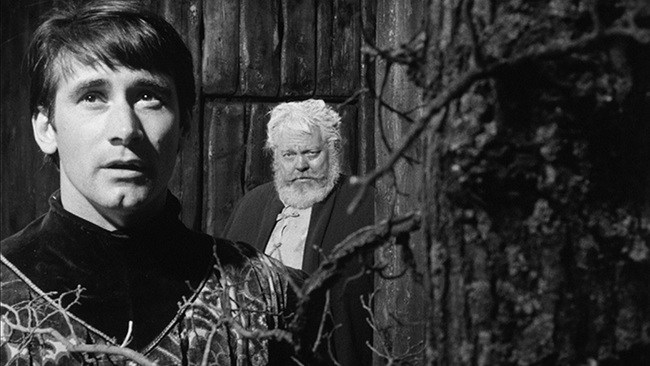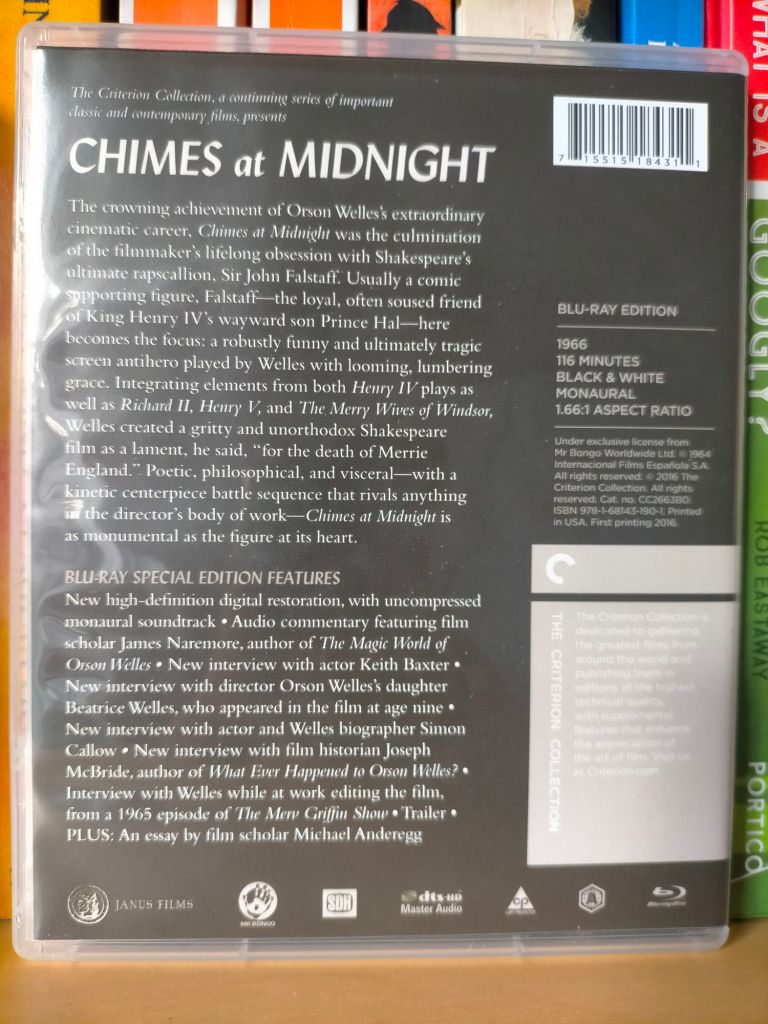We have heard the chimes at midnight, Master Shallow.
John Falstaff
This week on Andrew’s Reviews, I look at one of the greatest Shakespeare films of all time and Orson Welles’ cinematic masterpiece – Chimes at Midnight.

Throughout his distinguished career, actor/director Orson Welles was a lifelong fan and lover of William Shakespeare and his plays. Like Laurence Olivier, Welles starred and directed a trilogy of Shakespare films – Macbeth in 1948, Othello in 1951, and Chimes at Midnight in 1965.
Arguably the crowning jewel and achievement of his glittering career, Chimes was the culmination of his lifelong obsession of “Shakespeare’s greatest creation”, the knight Sir John Falstaff. The film centres on the relationship between Prince Hal and his ‘two fathers’ – his birth father, King Henry IV, and the father he adopts – Falstaff. The screenplay is an adapatation of Henry IV Parts 1 & 2, but also contains text from Richard II, Henry V, and the Merry Wives of Windsor.
Filmed on location in Spain in black and white, and recently restored in HD, Chimes of Midnight is an undisputed cinematic masterpiece and viewing experience. To secure funding for the film, Welles lied to his producer friend Emiliano Piedra that he would make an adaptation of Treasure Island, while never actually filming a scrap of footage, building sets and props that could be made in both films. As the culmination of Welles’ lifelong obsession with Falstaff, it represented the third time he portrayed the legendary knight, with previous stage attempts on Broadway titled Five Kings in 1939 (an adaptation of Shakespeare’s Henriad plays), and a production named Chimes of Midnight in Belfast and Dublin in 1960. Both previous attempts were failures, but he cast one of the previous actors from the play in this film – Keith Baxter, who played Prince Hal.
Whilst the film’s production values overall are technically sound and authentic, the film’s highlight by far is the widely celebrated Battle of Shrewsbury sequence – a six minute montage of over 200 brief and varied shots, in which Welles brilliantly exemplifies the true horrors, viciousness and brutality of war on the battlefield. It is a masterful blend of image and sound, and is an exemplary model of film editing and direction at its finest.
Yet the core of the film, by far, is Welles’ character of Falstaff, and his portrayal is arguably the best on screen, even over fifty years since its release. Funny, devious, kind, sweet and “virtueous”, Welles’ Fastaff is one of the most engrossing and entertaining of Shakespeare’s characters put to screen. Keith Baxter is also excellent as Prince Hal, and his relationship with Falstaff is brilliantly developed throughout, with several clues noting that his lifestyle and behaviour will change soon…
The supporting cast are also magnificient with some major Hollywood and Shakespearean actors – John Gielgud as King Henry IV, Margaret Rutherford as Mistress Quickly, and Jeanne Moreau as Doll Tearsheet. In particular, Gielgud is outstanding as the dying king with a guilty conscience – his delivery of the speeches and soliloquies are brilliant to watch, complemented by briliant cinematography of the church and court.

Unfortunately one minor issue with the film is the sound and dialogue. Due to the film’s modest budget, Welles often shot the film silent, dubbing and adding the sound in post production. As a result, sometimes the dialogue is often muffled, out of sync and difficult to hear clearly. This is largely mitigated by the 2016 restoration but some minor audio problems remain.
Lovingly restored and released by the Criterion Collection in 2016, Chimes at Midnight is a gem in Orson Welles’ distinguished career and one of the great Shakespeare film adaptations of all time.
Rating: 9/10



Further reading:
https://www.criterion.com/films/28756-chimes-at-midnight
https://www.criterion.com/current/posts/4201-chimes-at-midnight-falstaff-roars